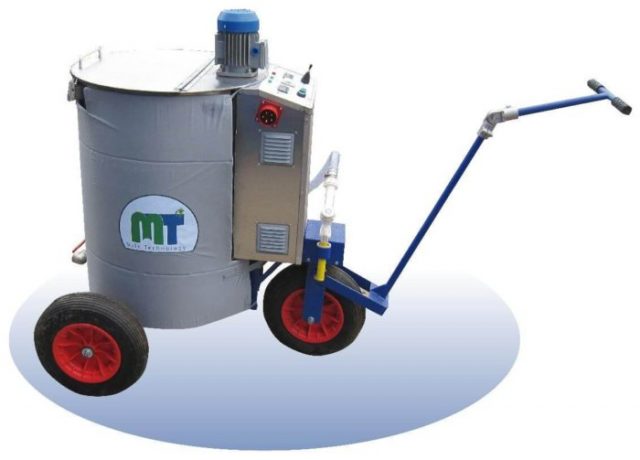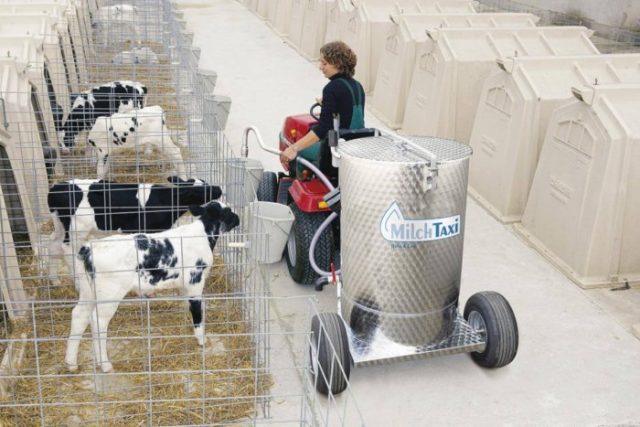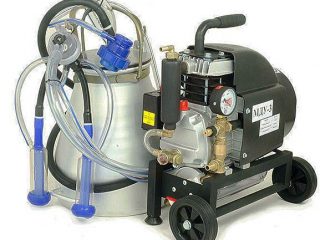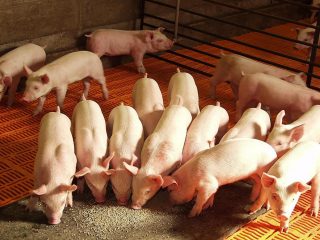Content
A milk taxi for feeding calves helps to properly prepare the mixture so that the little ones absorb vitamins and nutrients to the maximum. The equipment differs in the volume of the container, designed for a certain amount of feed, as well as other technical characteristics.
What is a milk taxi
At the age of one month, the calves on the farms are weaned from the cow. Young animals are fed backwards. Whole milk substitutes are often used for drinking. The mixture contains all the vitamin complex that babies need. Regardless of the composition, the product must be prepared in strict compliance with the technology before drinking. If the mixture is not properly prepared, all the nutrients in the composition will not be absorbed by the calves.
Milk Taxi was created to solve the problem. The equipment helps to prepare a mixture for drinking from the ingredients loaded into the container. The finished product meets the required parameters. The milk unit constantly maintains the temperature regime, the consistency of the drink, and dispenses feed in doses. Additionally, the equipment makes it easier for the farm staff to serve a large number of livestock.
Milk taxis are produced by different manufacturers. The principle of operation of the equipment is the same, but the models differ in their parameters:
- Any model of the milk machine is equipped with a container where the mixture is prepared for drinking. Its volume is designed for a certain number of calves. The indicator varies from 60 to 900 liters.
- There are two differences in the way of transportation. The devices are moved by operators manually or an electric drive is activated.
- Dairy equipment is produced with minimal functions or equipped with a computer automation unit. The second option is multifunctional. Automation is capable of preparing a drink from a whole milk substitute at once according to several recipes for young animals of different ages.
- There are models equipped with a liquid feed pasteurizer. In the process of its preparation, disinfection takes place.
- Wheels provide ease of movement for the milk machine. There can be three or four of them, depending on the model. The first option is maneuverable. The milk unit with four wheels is more stable.
- The material for making a taxi is stainless steel or durable polymers.
In order for the equipment to cope with its duties, the choice of a model is carried out taking into account its main parameters.
See the video for more information about the Milk Taxi:
Advantages and disadvantages
The technology of feeding young animals is popular in almost all countries. Milk machines are in demand on large farms and in private households where individual cattle are kept. Today a taxi has some advantages:
- The capacity of the milk unit is equipped with a mixer that mixes the ingredients without lumps. The liquid is not splashed, it is brought to the desired consistency. The prepared mixture is completely absorbed by the calf's body.
- The presence of heating allows you to keep the drinking mixture warm at all times. The optimum temperature for better assimilation is considered to be within 38aboutFROM.
- The dosed supply of the mixture helps to water the young animals of different ages in compliance with the established norms.
- The milk taxi is simple in design. The equipment is easy to wash after drinking, disinfect, clean the working gun.
- The comfortable wheelbase makes the taxi more agile.The equipment can be easily deployed in a small area, transported around the barn.
- Automation of the process simplifies the management of the device. If necessary, the operator can instantly change the calf feed dosage.
The equipment provides farm automation. The productivity of the farm increases, the labor costs of the service personnel are reduced. Calves grow faster and gain health. The downside is the initial cost of purchasing equipment, but it pays for itself in a couple of years.
How the milk taxi for calves works
Milk units differ in parameters, but they work according to the same principle:
- The operator pours the return into the container. If a whole milk replacer is used, a dry mixture is loaded into the tank, water is added (the dosage is indicated in the instructions on the milk replacer package). After filling the container with ingredients, the container is covered with a lid, fixed with latches.
- The mixture preparation parameters are set on the taxi control unit.
- The mixer is switched on. Simultaneously with stirring, the product is heated by heating elements to a temperature of 38 aboutC. Heating is allowed up to 40 aboutC. This value corresponds to the temperature of the milk of the cow.
- When the mixture is ready, the operator transports the equipment to the animal feeding area.
- The feed is dispensed through a pistol connected with a hose to the milk container. The operator pours the mixture to the calves into individual feeders. Milk machine sensors control the delivery of the set drinking rate. It is a big plus if the taxi is equipped with an electric pump. The knot helps to evenly feed the mix from the tank to each calf.
- At the end of the procedure, the remaining liquid feed is drained from the tank through the tap. Taxis are thoroughly rinsed and prepared for the next distribution.
The main labor input when working with a taxi is loading the container with ingredients. Then the operator only has to press the buttons on the control unit, wait for the result, and feed the young stock with the ready-made mixture.
Specifications
Each model of the Milk Taxi has individual parameters. However, the equipment is characterized by the presence of standard functions:
- heating;
- mixing the ingredients with a mixer;
- Feeding calves through a dispensing gun.
Of the additional functions, the following are considered common to each model:
- automatic setting and maintenance of doses;
- delivery of a given rate of liquid feed.
Dairy units of three series are widespread: "Economy", "Standard", "Premium". The heating function is available for every taxi model. The speed of the process depends on the volume of the milk tank. For example, 150 liters of feed will heat up from 10 aboutFrom to 40 aboutC in 90 minutes. For 200 liters of liquid feed, it takes 120 minutes.
In the presence of a pasteurizer, liquid calf feed is brought to a temperature of 63-64 aboutC. The process takes 30 minutes. After pasteurization, the milk mixture cools down to a temperature of 30-40 aboutC in 45 minutes with a tank volume of 150 liters. The cooling time depends on the amount of feed. For example, the parameter for a 200 l container is increased to 60 minutes.
The power of most taxi models is within 4.8 kW. The weight of the equipment ready for calf feeding depends on the volume of the feed tank. For example, a milk machine with a 200 liter capacity weighs approximately 125 kg.
Features of operation
From the first days, the calves consume colostrum. Young animals are transferred to return and whole milk replacer at the age of one month. Feeding is carried out from special feeders equipped with teats for calves. It is here that the mixture prepared in the taxi is poured.
At the end of the drinking, the remains of the feed are drained from the barrel of the apparatus through the tap, the distribution hose is released. Water is poured into the tank with a temperature of 60 aboutC, add the detergent. Taxis are switched to recirculation mode. After stopping the process, the inside of the tank is additionally cleaned with a soft brush. The soap solution is drained. The tank is filled with clean water, the procedure is repeated. The end of the taxi service is to clean the milk filter.
Conclusion
A milk taxi for feeding calves is profitable for farmers. The equipment is guaranteed to pay off. The farmer makes a profit by increasing the productivity of his farm.












